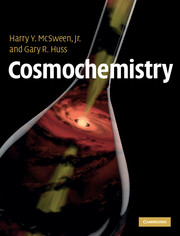Book contents
- Frontmatter
- Contents
- Preface
- 1 Introduction to cosmochemistry
- 2 Nuclides and elements: the building blocks of matter
- 3 Origin of the elements
- 4 Solar system and cosmic abundances: elements and isotopes
- 5 Presolar grains: a record of stellar nucleosynthesis and processes in interstellar space
- 6 Meteorites: a record of nebular and planetary processes
- 7 Cosmochemical and geochemical fractionations
- 8 Radioisotopes as chronometers
- 9 Chronology of the solar system from radioactive isotopes
- 10 The most volatile elements and compounds: organic matter, noble gases, and ices
- 11 Chemistry of anhydrous planetesimals
- 12 Chemistry of comets and other ice-bearing planetesimals
- 13 Geochemical exploration of planets: Moon and Mars as case studies
- 14 Cosmochemical models for the formation of the solar system
- Appendix: Some analytical techniques commonly used in cosmochemistry
- Index
- References
9 - Chronology of the solar system from radioactive isotopes
Published online by Cambridge University Press: 05 June 2012
- Frontmatter
- Contents
- Preface
- 1 Introduction to cosmochemistry
- 2 Nuclides and elements: the building blocks of matter
- 3 Origin of the elements
- 4 Solar system and cosmic abundances: elements and isotopes
- 5 Presolar grains: a record of stellar nucleosynthesis and processes in interstellar space
- 6 Meteorites: a record of nebular and planetary processes
- 7 Cosmochemical and geochemical fractionations
- 8 Radioisotopes as chronometers
- 9 Chronology of the solar system from radioactive isotopes
- 10 The most volatile elements and compounds: organic matter, noble gases, and ices
- 11 Chemistry of anhydrous planetesimals
- 12 Chemistry of comets and other ice-bearing planetesimals
- 13 Geochemical exploration of planets: Moon and Mars as case studies
- 14 Cosmochemical models for the formation of the solar system
- Appendix: Some analytical techniques commonly used in cosmochemistry
- Index
- References
Summary
Overview
In this chapter, we review what is known about the chronology of the solar system, based on the radioisotope systems described in Chapter 8. We start by discussing the age of materials that formed the solar system. Short-lived radionuclides also provide information about the galactic environment in which the solar system formed. We then consider how the age of the solar system is estimated from its oldest surviving materials – the refractory inclusions in chondrites. We discuss constraints on the accretion of chondritic asteroids and their subsequent metamorphism and alteration. Next, we discuss the chronology of differentiated asteroids, and of the Earth, Moon, and Mars. Finally, we consider the impact histories of the solar system bodies, the timescales for the transport of meteorites from their parent bodies to the Earth, and the residence time of meteorites on the Earth's surface before they disintegrate due to weathering.
Age of the elements and environment in which the Sun formed
The presence of radioactive isotopes in meteorites and planets demonstrates that the atoms that make up our solar system are not infinitely old. On the other hand, the abundance ratios for radioactive species, such as 235U/238U, in the solar system when it formed were much lower than the ratios in which they were produced at the stellar source, as determined from detailed nucleosynthesis models. This indicates that these isotopes were not produced at the time of solar system formation.
- Type
- Chapter
- Information
- Cosmochemistry , pp. 308 - 353Publisher: Cambridge University PressPrint publication year: 2010
References
- 1
- Cited by



